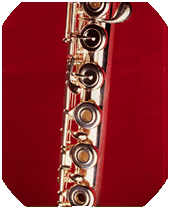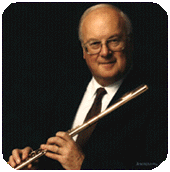BY MICHEL DEBOST


|
For flutists young and old, most of the difficulties in playing are of an instrumental nature, including fingers, breath control, tone
quality, and articulation. Only when such impediments are diagnosed and corrected, can the grammar of phrasing and interpretation begin
to mature. Even the greatest performers continue to the elusive question of what is style?
Some people have the idea that style is going for the richest and most ostentatious, such as flaunting money and life-style. The same thing happens in music, fashion, and cooking. The more stuff that is added, the more neighbors and colleagues are likely to be impressed. Fashion and cosmetics tend to exaggerate, yet make-up should not be noticed. When the paint is applied excessively, the face of Venus becomes a clown. Although clowns are sometimes funny, they are often pathetic. In the Baroque style of music the ornamentation can become ridiculous. In his treatise of 1750 Quantz gave examples of extreme ornamentation that disfigures a simple line. "Style is a very simple way of saying very complicated things," according to Jean Cocteau (1889-1963), novelist, playwright, and poet. Beware of musical editions and foodstuffs. It is hard to find today anything that has not been improved, from milk, bread, vitamins, soap, and toothpaste to sugar, salt, and of course, improved music. Just as Mahler reorchestrated Schumann, and even Beethoven, why then cannot editors do likewise with the most cherished repertoire? Even though it would seem impossible to improve a classical painting, some old Biblical scenes with nudity were painted over by order of the Church, supposedly to preserve some kind of sick morality. Once man faced up to God, the Michel paintings were restored. Everybody claims that simple and fresh foods are the best, yet a fast food chain advertises a sandwich with five meats, three cheeses, and everything on it. The customer gets more for his money but in the process, loses the essential taste of individual content. On a recent flight, I was served a salad with a small container of dressing; and, being bored, l read the label. Until then I thought that salad dressing was simple, made from basic ingredients according to ones preference, a bit more of this, a bit less of that. This one must have been improved because the ingredients included soybean oil, sour cream, milk, locust bean gum, carageenan, enzymes, water, vinegar, eggs, lemon juice from concentrate, egg yolks, cucumbers, corn syrup solids, salt, sugar, herbs and spices, onion, mustard flour, natural flavor (not specified), xanthan gum, and garlic. Phew! All that in one ounce of "Naturally Fresh." Flute style is sometimes like this when too many ingredients are added to the basic mix in an effort to improve it: stuff the low notes here, put in a good buzz there; cut through the sound at any cost. As a listener, l do not like the flute to reach my ears with the forceful sound of a trombone. I have nothing against the trombone, but I prefer the flute to sound like itself: poetic and fragile, not the bazooka sound produced by some recent mouth' pieces. Let your flute play its own color: dark and soft in the low notes, brilliant and lyrical in the third octave, warm and human in the middle range. The works of the 17th and 18th centuries, generally classified as Baroque music, are an example of how styles can vary. With the best of intentions, J.S. Bach was edited with metronomic tempos and dynamics of the Romantic era, then performed by full Wagnerian orchestras and huge organs. Many editions of Handel and Bach flute Sonatas are loaded with indications which many teachers and students accept as the gospel, but these indications are stylistically dubious. Before 1800 performance styles varied from one province to the next. The Hamburg A was not the Coethen A, the Versailles Menuet was faster than the Venetian Minuetto. Italian style exemplified the singing quality of instrumental playing. French style had an elegant dryness, an elaborate precosity all its own. German music symbolized the glory of Divinity and man's effort to praise God. Until J.S. Bach laid the ground work for equal temperament, the tuning system that divided the octave into twelve semitones, it was common for a harpsichord to be tuned by each harpsichordist. Some historical organs of the same period are tuned to a very high pitch while others to a very low pitch. The Rothenhurg flute did not prevail in France or Italy. Hotteterre called his instrument flute allemande (German flute), but it came from La Couture-Bousset in Normandy. How can anyone claim that a particular musical choice is absolutely authentic, much less whether it is desirable? Andre Malraux (1901 - 1976) wrote, "What is Art? That by which forms become style." For my taste in matters of style, less is more. Don't try to say too much. In musical interpretation, good style is doing as little as possible "Hide Art with Art itself, as Jean-Philippe Rameau (168:3-1864) wrote. Simplicity is not easy; Edouard Herriot said, ''Culture is what is left when everything has been forgotten." Along this same line Denis concurred, "The desire for the extraordinary is the character of mediocrity. When one despairs to achieve a beautiful, simple, and natural thing, he seeks something bizarre." Henri Beyle, alias Stendahl 1783-1842: - French writer, author of Le Rouge et le Noir (The Red and the Black) agreed when he said, "For vain and cold souls, complication and difficulty are beauty.'' We cannot express what we have not felt. Once we have learned and studied the basic elements of style (rhythm, tempo, form), analyzed the historic ( instrument characteristics, pitch) and compositional (structure, harmony) parameters, we must go back to simplicity. "Talent is knowing how far one can go too far," according to Cocteau. Most of the conductors, soloists, and singers I admire have a quality of inimitable simplicity. In their care, music becomes evident. The concert format is a relatively recent historical event. Only a few centuries ago the Church considered instruments as pagan and their presence near the altar as sacrilegious. Only the voice was holy. Plain chant, a line of musical support for liturgical text, was not accompanied; in fact, to this day, a cappella (in a chapel style) means without instrumental support. In medieval Europe the Church was the center of popular life: it towered over the market place, shops, taverns, and places of pleasure. Even today the market is the heart of a European city. Instruments were the realm of the street, never crossing the threshold of a place of worship, yet on the church steps were drums, tambourines, cymbals to give the beat for instruments, especially winds that carried the tunes. This music was essentially dance music, either slow or fast, that was often given a name that described its geographical origins or rhythmic character: Siciliano, Gavotte, Sarabande, Polonaise, Bourree, Passacaille, Rigaudon, etc. Religious pageants, chansons de geste, told the stories of heroes and saints. At this time court music was the art of the troubadour, who told leg' ends, tales of love, and poems, punctuated by a lute or a harp, to the inner circle of the nobility. The Renaissance brought great artistic upheaval. Migrations brought foreign influences, and barriers of style were broken. Merchants became rich burgers and competed with the lords of the land for the services of musicians. Slowly the Church's austerity gave way to stylish and lavish services, in which instrumental music found a place. This description is, of course, schematic, but it shows that the styles of music began in the Church and evolved to Baroque and Classical forms and eventually to Romanticism and modern concepts of composition. Music cannot be compartmented arbitrarily. The rhythms and characters of the last two centuries of music relate to Baroque, which has its roots in medieval sacred singing and dance forms. Even if musical works have lost their dance names or religious implications as metronomic indications gained way, all musicians should understand that as a general rule, phrasing relates to the voice and rhythm relates to instrumental dance. The great merit of the Baroque revival, more than the pro forma authenticity of period instruments, is its quest for these stylistic roots. To appreciate style, rely not on the sacrosanct metronome, which in many cases is only an indication added by a long forgotten performer or editor, but on the inner character of the music. Most slow movements are akin to the voice, while faster paces have as ancestors the old street dances of yesteryear. |